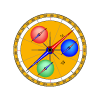Speaker
Michael Engelhardt
(New Mexico State University)
Description
Quark orbital angular momentum (OAM) in the nucleon can be evaluated directly by employing a Wigner function embodying the simultaneous distribution of parton transverse position and momentum. This distribution can be accessed via a generalization of the nucleon matrix elements of quark bilocal operators which have been used previously in the lattice evaluation of transverse momentum dependent parton distributions (TMDs). By supplementing these matrix elements with a nonzero momentum transfer, mixed transverse position and momentum information is generated. In the quark bilocal operators, a gauge connection between the quarks must be specified; a staple-shaped gauge link path, as used in TMD calculations, yields Jaffe-Manohar OAM, whereas a straight path yields Ji OAM. A lattice calculation at a pion mass of 518 MeV is presented which demonstrates that the difference between Ji and Jaffe-Manohar OAM can be clearly resolved. The obtained Ji OAM is confronted with traditional evaluations utilizing Ji's sum rule. Jaffe-Manohar OAM is enhanced in magnitude compared to Ji OAM.
Author
Michael Engelhardt
(New Mexico State University)

